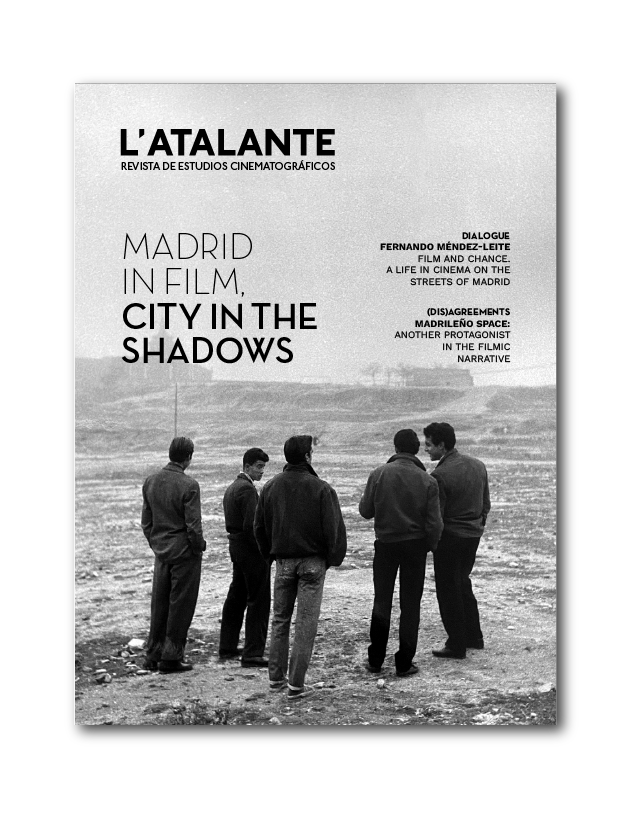Published 2023-07-31
Keywords
- Street Film,
- Film Space,
- Film Cartography,
- Borderscape,
- Urban Islands
How to Cite
Copyright (c) 2023 L'Atalante. Journal of film studies

This work is licensed under a Creative Commons Attribution-NonCommercial-NoDerivatives 4.0 International License.
Abstract
The objective of this study is to explore the portrait of Madrid in Princesses (Princesas, Fernando Leon de Aranoa, 2005). At an intersection between studies of film space, urban geography, and the recent border studies, the theoretical framework of this paper is applied to a film that was considered a symptom of aesthetic changes in Spanish cinema at the beginning of the new millennium. The film offers a critical reading of Madrid in the midst of substantial changes toward globalisation by focusing on its invisibilised and marginalised urban spaces and their inhabitants. An important feature of the film is its exploration of subaltern characters who cross the city’s invisible borders in their day-to-day negotiation with the spatial interpellation. The main focus of this paper is therefore on examining the relationship of this film portrait with different urban islands and their corresponding borders.
Downloads
References
- Bhabha, H. y Rutherford, J. (1990). Interview with Homi Bhabha: The Third Space. En J. Rutherford, Identity: Community, Culture, Difference (pp. 207-221). Londres: Lawrence & Wishart.
- Black, K. (2011). Borrando fronteras (invisibles): La prostitución y los inmigrantes de Madrid en “Princesas” de Fernando León de Aranoa. Hispanic Journal, 32(2), 79-93.
- Brambilla, C. (2015). Exploring the Critical Potential of the Borderscapes Concept. Geopolitics, 20(1), 14-34. https://doi.org/10.1080/14650045.2014.884561
- Goldsmith, W. W. (2000). From the Metropolis to Globalization: The Dialectics of Race and Urban Form. En P. Marcuse y R. van Kempen (eds.), Globalizing Cities: A New Spatial Order? (pp. 37-55). Oxford: Blackwell.
- Gómez Maturano, R. (2014). Nuevos conceptos o nuevos relatos: la fragmentación urbana, Anuario de investigación del posgrado en urbanismo, 1(0), 253-265.
- Habermas, J. (2000). La constelación postnacional: ensayos políticos. Trad. Pere Fabra Abat. Barcelona: Paidós.
- Hayward, S. (2000). The City as Narrative: Representations of Paris in French Cinema (1930-1990s). En M. Konstantarakos, (ed.), Spaces in European Cinema. Bristol: Intellect Books.
- Jameson, F. (1991). Postmodernism, or the Cultural Logic of Late Capitalism. Durham: Duke University Press.
- Lazzarini, A. (2015). Metamorphosis of City Borders. En C. Brambilla, et al. (eds.), Borderscaping: Imaginations and Practices of Border Making (pp. 177-186). Londres: Routledge.
- Lobo, O. (2013). Princesas de Fernando León de Aranoa (2005) o la invención cinematográfica de un espacio hospitalario. ILCEA. Revue de l’Institut des langues et cultures d’Europe, Amérique, Afrique, Asie et Australie, 18, 1-24.
- Marcuse, P. , Van Kempen, R. (eds). (2000). Globalizing Cities: A New Spatial Order? Malden: Blackwell.
- Marcuse, P. (1989). Dual City: A Muddy Metaphor For a Quartered City, International Journal of Urban and Regional Research, 13(4), 697-708. https://doi.org/10.1111/j.1468-2427.1989.tb00142.x
- Michelle Murray, N. (2014). The politics of looking in Fernando León de Aranoa’s Princesas (2005). Studies in Spanish & Latin American Cinemas, 11(3), 241-253.
- Moyo, A. (2017). Knowing One’s Place: Mapping Landscapes in and as Performance in Contemporary South Africa. En M. Nieuwenhuis y D. Crouch, (eds.), The Question of Space: Interrogating the Spatial Turn Between Disciplines (pp. 23- 42). Londres: Rowman & Littlefield.
- Nogué, J. (2009). Paisajes de frontera: los límites de la ciudad, Mètode: Anuario, 104-111.
- Nogué, J. (2011). Otros mundos, otras geografías. Los paisajes residuales, Revista da ANPEGE, 7(1), 3-10. https://doi.org/10.5418/RA2011.0701.0001
- Quintana, A. (2008). Fernando León de Aranoa: Princesas (2005) y el realismo tímido en el cine español. En P. Feenstra y H. Hermans (eds.), Miradas sobre pasado y presente en el cine español (1990-2005) (pp. 251-264). Amsterdam: Rodopi.
- Roberts, L. (2018). The Question of Space: A Review Essay, Humanities, 7(2), https://doi.org/10.3390/h7020042
- Sanjuán-Pastor, C. (2013). Imágenes del margen en la ciudad global española: la “mujer de la calle” como metáfora espacial en Todo sobre mi madre (1999) de Pedro Almodóvar y en Princesas (2005) de Fernando León de Aranoa. Letras Femeninas, 39(1), 49-66.
- Schimanski, J. H. (2015). Reading Borders and Reading as Crossing Borders, Transactions, 22, 91-107. Recuperado de http://urn.nb.no/URN:NBN:no-68230
- Schimanski, J., Wolfe, S. (2013). The Aesthetics of Borders. En K. Aukrust (ed.), Assigning Cultural Values (pp. 235-250). Frankfurt: PL Academic Research.
- Stavrides, S. (2016). Hacia la ciudad de umbrales. Madrid: Akal.
- Van Liew, M. (2012). Transnational Reciprocity: Liminal Love in Fernando León de Aranoa’s Princesas. Quarterly Review of Film and Video, 29(5), 450-457.

